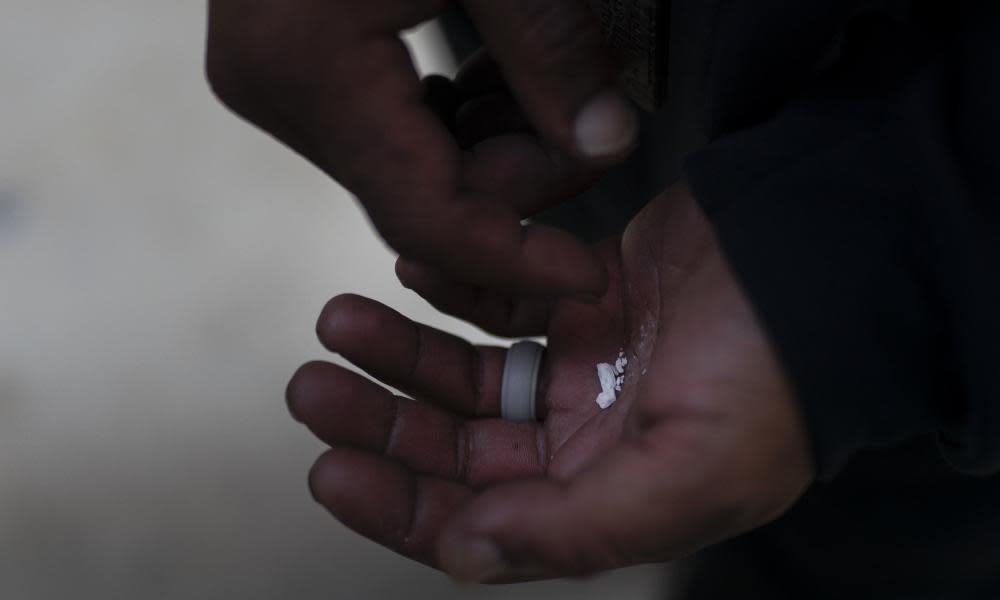Fentanyl deaths in Los Angeles county rose 1,280% from 2016 to 2021 – report

Fentanyl deaths and hospitalizations have surged in Los Angeles county, with a 1,280% increase in fatalities from 2016 to 2021, according to a new report on the public health crisis.
The LA county public health department released data on Tuesday revealing that 1,504 people suffered fatal fentanyl overdoses in 2021, nearly 14 times as many deaths as in 2016 when 109 people died. Last year’s death toll also marks a 31% increase from 2020. From 2016 to 2020, there was also a 308% increase in emergency department visits for fentanyl, from 133 cases to 542 cases.
Related: The daily battle to keep people alive as fentanyl ravages San Francisco’s Tenderloin
The epidemic in LA, the largest county in the US, mirrors disturbing trends across the country, where the number of overdose deaths increased to record-breaking levels last year. Fatalities linked to synthetic opioids such as fentanyl increased from 58,000 in 2020 to 71,000 in 2021, and fentanyl is now the most common drug linked to overdoses.
Fentanyl, which is 50 times more potent than heroin and cheap to make, has been found in most forms of street drugs and counterfeit pills, the LA health department said.
The number of youth overdoses has also sharply increased in the US and in LA county. In the LA public school system, at least seven teenagers have overdosed this year from pills potentially laced with fentanyl, including a 15-year-old girl who died in September. Among youth ages 12 to 17 who suffered fatal overdoses in LA county in 2021, 92% tested positive for fentanyl, which was higher than older groups, the report said. A total of 31 youth ages 17 and under died from fentanyl last year, compared to 28 in 2020 and nine in 2019.
Fentanyl deaths in LA have increased for all races and ethnicities, the report said, but the epidemic has disproportionately impacted Black residents, who make up 8% of the broader population but accounted for 17% of fatalities last year. Death rates were also higher in neighborhoods with greater levels of poverty, and the health department reported earlier this year that fentanyl was contributing to a significant increase in overdose deaths among unhoused people in the region.
Health officials emphasized the importance of expanding harm reduction strategies, including increased access to Narcan, a drug that can revive someone who has overdosed; fentanyl test strips that can detect counterfeit pills; and safer consumption sites.
LA county officials also announced a new working group on Tuesday to target the crisis, which will include the public health department, the district attorney’s office, the LA school district, law enforcement officials and the Drug Policy Alliance, an advocacy group.
Related: Killed by a pill bought on social media: the counterfeit drugs poisoning US teens
“The tragedies resulting from fentanyl are indiscriminately impacting all populations regardless of age, race, ethnicity, or socioeconomic status,” Dr Barbara Ferrer, public health director, said in a statement. “Fentanyl’s reach is unfortunately broad, calling for a similarly broad approach to address the crisis.”
While the crisis has led some prosecutors to pursue harsher punishments, LA district attorney George Gascón, who has pursued progressive policies to reduce incarceration rates, said in a statement Tuesday that a “multifaceted approach is necessary”. He added: “If the failed ‘War on Drugs’ of the ’90s has taught us one thing, it is that we cannot incarcerate our way out of a public health issue. Enforcement is not enough. Saving lives is the priority when addressing substance abuse and illicit drug use, as only the living have the opportunity to recover.”
“The proliferation of fentanyl-related deaths poses one of the gravest challenges of our times,” Gascón said.

 Yahoo News
Yahoo News 
